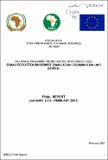| dc.description.abstract | This final report of Somali Ecosystem Rinderpest Eradication Coordination Unit (SERECU) provides an overview of project justification and objectives, achievements, constraints, lessons learnt and suggested recommendations. SERECU was established within AU-IBAR to manage and coordinate a time-bound regional program with the end point being the verification of absence of rinderpest infection, and OIE accreditation of rinderpest freedom for the entire Somali Ecosystem (SES) countries. The initial 6 months SERECU work-plan and cost estimate worth 955,000 euros was endorsed on 22nd November 2005 to start operations immediately alongside the main PACE Extension work-plan and cost estimate. The operations did not start until 1st January 2006. After 10 months of operation, an Addendum was prepared and endorsed for an extension phase of 4 months (November 2006 - February 2007), bringing the total project cost to 1,818,928 euros (equivalent KSh. 160,700,247 ® exchange rate: 1 euro = 88.0268 KSh). The overall objective of SERECU is to contribute to poverty reduction of those involved in livestock-farming sector through eradication of rinderpest and control of major trans-boundary diseases. The project purpose is in line with the first specific objective of the Extension Phase of PACE and was to develop and implement a harmonized and coordinated strategy for rinderpest eradication from the Somali ecosystem. The project had four expected results, namely: n SERECU established and functioning for technical and logistical support to national disease surveillance and control systems n Rinderpest surveillance systems in the Somali ecosystem coordinated and areas of rinderpest infection or freedom clearly delineated based on risk assessment approaches as agreed with concerned countries n Harmonized rinderpest eradication approach applied by veterinary delivery systems in the SES n Final rinderpest eradication strategy prepared, endorsed and coordinated Important achievements during the 14 months of operation are: o SERECU has strengthened dialogue among the countries and with IBAR, as a means towards ensuring coordinated and harmonized field investigations and integrated epidemiological data analysis o Stakeholders in the SES have been sensitised and are more committed to rinderpest eradication efforts as demonstrated by signing and upholding of memoranda of understanding between individual countries/ institutions and AU-IBAR SERECU Final Report iv
o Gaps and needs in veterinary delivery systems in the SES for underpinning future interventions in the eradication of rinderpest have been identified o Cooperative linkages and productive working relationships have been reinforced with international stakeholders such as FAO GREP, 01E, and International Reference laboratories. o A proposal has been developed and submitted to the OIE seeking to adapt the Chapter on Rinderpest and the accompanying surveillance requirements of the OIE Terrestrial Animal Health Code to the specificity of mild rinderpest in achieving freedom from disease. The outcome is awaited at the May 2007 OIE General Assembly and will henceforth influence the future progression of countries along the OIE pathway, particularly Somalia. o Mathematical modeling of mild rinderpest was done using available data and the results of this analysis are consistent with either fade-out of infection or an inter-epidemic period where disease persists in remote communities. The results have contributed to the formulation of final rinderpest eradication strategy. o Ethiopia and Kenya achieved OIE recognition of disease freedom on zonal basis in 2005 and 2006 respectively and both have now applied for freedom from disease at country level (outcome awaited in May 2007). Somalia declared countrywide provisional freedom from rinderpest in January 2007. o A final strategy for the eradication of rinderpest focusing on demonstration of rinderpest freedom, guarding against any risk of rinderpest resurgence and achievement of OIE accreditation of freedom status has been formulated and advanced as contained in SERECU Phase Project Proposal (2007- 2009). Should the verification process identify rinderpest endemicity, the strategy and planning will be adapted accordingly. o A project proposal (both Technical and Financing Agreement) for SERECU phase II (2007- 2009) has been drafted and forwarded to the European Union for their consideration for funding. Conclusion and Recommendations SERECU was operationalised under the aegis of AU-IBAR and has functioned effectively, and dynamically managed its activities, and thereby set a basis for the necessary continuity of a coordinated rinderpest eradication process beyond PACE. This model could be duplicated in other ecosystems/regions to control/ eradicate other trans-boundary diseases. For the future, the following recommendations are put forward. i. An immediate follow-up by specially constituted teams including AU-IBAR, SAHSP, FAO and the 3 SES countries should be conducted in sero-positive sites in SERECU Final Report
Somalia and contiguous areas of neighbouring countries as soon as the security concerns are resolved. The results of the mission should shape the final eradication strategy. ii. The outcome of the concept note submitted to the OIE in August 2006 for the adaptation of the Rinderpest Chapter should be actively followed up, as will further guide the eradication strategy. iii. AU-IBAR/SERECU has prepared and submitted to the EC a proposal for a two-year follow-up project. The support of this proposal is necessary to further consolidate the achievements made by PACE/SERECU. SERECU should be sustained and strengthened to provide the needed analytical and operational assistance at national and SES regional level. For the next phase, the current SERECU structure and staff should be maintained if and where possible to harness the valuable experiences gained from the regional approach and the strong linkages so far developed with implementing partners. iv. PPR vaccine trial for the protection of cattle against rinderpest started under PACE should be concluded under phase II of SERECU. v. In SERECU Phase II it is proposed that other selected trans-boundary diseases be addressed as a way to add value and optimize on the eradication efforts for rinderpest | |
